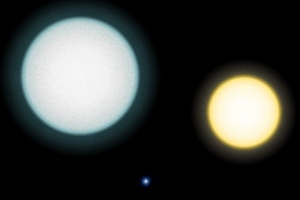Blog
Small, But Mighty
15 December 2013
 RJ Hall, CC BY-SA 3.0
RJ Hall, CC BY-SA 3.0One way in which stars are categorized is by spectral type. In the late 1800s we started to be able to measure the spectra of stars, which gave us the ability to determine the color of stars. By the early 1900s, astrophotography allowed us to measure the color at which a star was brightest, and this led to the formal spectral types we use today.
In the mid-1800s, we began to understand how the light emitted by a hot object can depends on its temperature. Studies by Gustav Kirchhoff and others had found that the light given off by such an object is a continuous spectrum, and the wavelength at which the spectrum is brightest depends on its temperature. We see this effect when metal is heated, first glowing dim red, then brighter orange, then bright yellow-white as it is heated. By measuring the spectrum of a blackbody (or an approximate blackbody) we can determine its temperature.
This meant that categorizing stars by spectral type was a way of categorizing them by temperature. By 1910 Hertzsprung and Russell had plotted graphs of the brightness (absolute magnitude) of stars versus their spectral type (now known as Hertzsprung-Russell diagrams), and demonstrated that hotter stars tended to be brighter stars, while cooler stars tended to be smaller. Since the absolute magnitude of a star depends not only on its temperature, but also its size, this meant that bright stars tended to be larger and dimmer stars tended to be smaller.
Then in 1914, Walter Adams measured the spectral type and absolute magnitude of a companion star to 40 Eridani (although he referred to it as Omicron Eridani). His 1-paragraph “paper” determined the companion to be an A-type star (white in color) which meant it was much hotter than a star like our Sun. One would expect the star would be bright as well, but Adams found that it was actually quite dim.1
The only way for the star to be both bright and dim was for it to be very small. But how could such a small star be so incredibly hot? It turns out it isn’t a normal kind of star. “Normal” stars, which we call main sequence stars, produce heat in their cores by fusing hydrogen into helium. But this new kind of star doesn’t. Instead it is a remnant core of a star that has collapsed to about the size of Earth. The star is so compressed that its temperature is very high, about 16,000 Kelvin. But being so small it isn’t bright compared to other hot stars.
We now know this kind of star as a white dwarf.
Adams, Walter S. “An A-type star of very low luminosity.” Publications of the Astronomical Society of the Pacific 26 (1914): 198. ↩︎